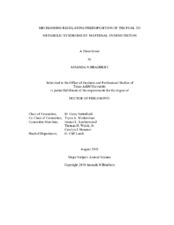| dc.description.abstract | The effects of maternal overnutrition in mares has yet to be fully elucidated; therefore, the objectives of these studies were to determine the effects of maternal overnutrition on neonatal foals at cellular and molecular levels to describe fetal origins of adult disease in the horse.
To test these objectives, 16 Quarter Horse mares were used in a completely randomized design and separated by BW, BCS and expected foaling date into one of two dietary treatments consisting of a control (CON; n=8) where diets were formulated to meet dietary requirements during late gestation or overfed (HIGH; n=8) where mares received 40% above CON.
Results indicate reduced insulin sensitivity in HIGH mares prior to parturition (P≤0.02) but was not observed in foals immediately postpartum. Pancreas of HIGH foals had greater number and size of endocrine islets determined by immunohistochemical staining (P≤0.01). Relative intensity of immunofluorescent immunoreactive insulin, glucagon and somatostatin within individual islets were not different, however.
Skeletal muscle of HIGH foals expressed larger individual fibers (P≤0.09) and a shift towards type I slow twitch fibers (P≤0.04). Changes in expression of genes involved in insulin-stimulated glucose uptake were also observed. Specifically, reduced expression of glucose transporter 4 and increased expression of insulin receptor isoform B and insulin-like growth factor 1 receptor. Furthermore, key proteins involved in intracellular insulin signaling were influenced, specifically through increased activation of extracellular signal-regulated protein kinase 1/2 (ERK1/2) and c-Jun N-terminal kinase (JNK).
Spleen mass was larger in HIGH foals compared to CON (P=0.04), which also resulted in an increase in RBC storage (P<0.01).
Lymphocyte localization was not different between dietary treatments; therefore, differences may be with innate immune cells. Collectively, these data are the first to describe the influence of maternal overnutrition on molecular mechanisms related to the predisposition of foals to insulin resistance. | en |


